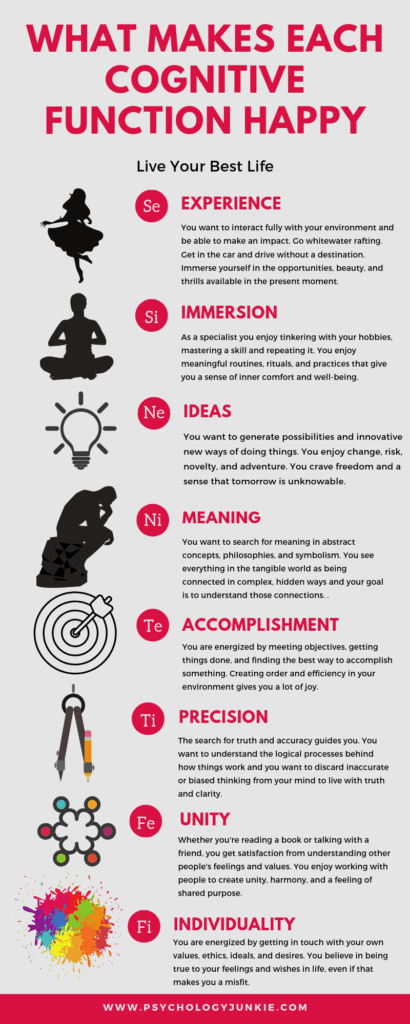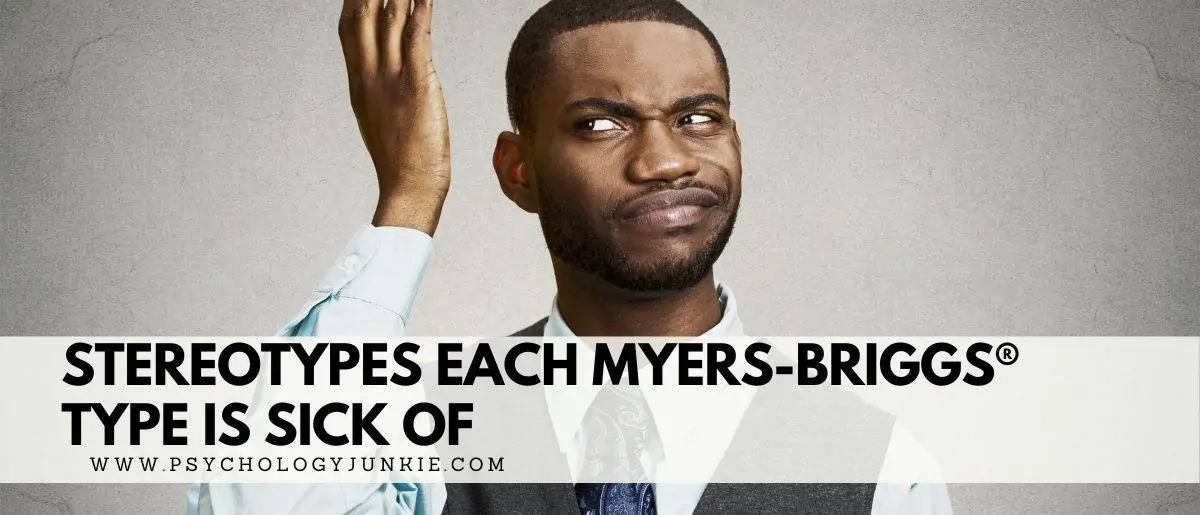The Extroverted Side of Each Myers-Briggs® Personality Type
Last week we explored the introverted side of each of the 16 Myers-Briggs® personality types. We talked about how there is no “pure” introvert or extrovert, and how everyone is some form of ambivert. This theory matches up with what Carl Jung proposed in his book on Psychological Types. Just like we all have an introverted side, we all have an extroverted side.
Why Do All 16 Personality Types Have an Extroverted Side?
The MBTI® assessment is based on the theory that people have different psychological preferences which can be divided into four pairs. These are Extroversion-Introversion, Sensing-Intuition, Thinking-Feeling and Judging-Perceiving. But these preferences are only one part of who you are. A right-handed person has a preference for their right hand, but can still certainly use their left hand (and does, hundreds of times per day!). The introvert has a preference for introversion, but still moves and flows through the extroverted world every day and has certain personality traits that show up in an extroverted way. The extrovert has a preference for extroversion, but still introspects, considers, and draws inward to make assessments and reflect.

The Cognitive Functions
One part of Myers-Briggs’ theory that isn’t talked about in many circles is the area of cognitive functions. Cognitive functions are essentially how you take in information, make decisions, and interact with your environment. Each type’s cognitive functions make up the basis of their Myers-Briggs type. The idea is that there are eight total possible functions represented by MBTI® types: four introverted and four extroverted.
The names of the cognitive functions are: Extroverted Feeling (Fe), Extroverted Thinking (Te), Extroverted Intuition (Ne), Extroverted Sensing (Ne), Introverted Feeling (Fi), Introverted Thinking (Ti), Introverted Intuition (Ni), and Introverted Sensing (Si).
All of the personality types have access to all of the functions and can use them to varying levels of proficiency and with varying levels of comfort.
As an example, let’s take a look at the ESFJ personality type. Here is the ESFJ’s primary cognitive function “stack”:
Dominant Function: Extroverted Feeling (Fe)
Auxiliary Function: Introverted Sensing (Si)
Tertiary Function: Extroverted Intuition (Ne)
Inferior Function: Introverted Thinking (Ti)
If you look closely, you can see a pattern. The first preference is extroverted, the second is introverted, third is extroverted, and so on. But the function that is dominant is extroverted (Extroverted Feeling specifically).
Let’s look at an introverted personality type. We’ll look at the INFJ. Here is the INFJ’s cognitive function stack:
Dominant Function: Introverted Intuition (Ni)
Auxiliary Function: Extroverted Feeling (Fe)
Tertiary Function: Introverted Thinking (Ti)
Inferior Function: Extroverted Sensing (Se)
As you can see, the INFJ also has introverted and extroverted functions, but their dominant function is introverted in nature.
In the end, Carl Jung was right, none of us is a pure introvert or extrovert. We have pieces of ourselves that we show in an introverted way, and pieces of ourselves that we express in an extroverted way – all varying in strength from one type to the next.
Not sure what your personality type is? Try out our most highly recommended personality questionnaires:
- You can take our free personality questionnaire here
- You can take Personality Hacker’s personality questionnaire.
- You can take the official Myers-Briggs Type Indicator® for $49.95
This article contains an affiliate link to a questionnaire on Personality Hacker. If you purchase one of their courses, I get a small kickback that I can use to pay for hosting and other demands of this site. I only recommend courses I love.
The Extroverted Side of Each Myers-Briggs® Personality Type
The ISFJ “Protector”
Extroverted Functions: Extroverted Feeling (Fe) and Extroverted Intuition (Ne)
Introverted Functions: Introverted Sensing (Si) and Introverted Thinking (Ti)
ISFJs use their extroverted functions to reach out and create warmth and connection with others. With an Extroverted Feeling element, ISFJs naturally attune to others’ emotions and notice changes in mood and demeanor. They have a natural drive to get peoples’ emotional needs met and create positivity in their environment. While ISFJs are indeed introverts, they can appear warm, friendly, and empathetic when socializing; especially one-on-one.
The extroverted intuition of the ISFJ shows up often in the creative realm. ISFJs often enjoy creatively using materials to come up with new ideas; crafts, recipes, home decor, landscape designs, the list goes on and on. While ISFJs often focus on what exists in the present, during moments of relaxation they can enjoy imagining possibilities beyond the present. They also enjoy using quirky, random humor to connect with people and cope with tough situations in life.
Find Out More About ISFJs: The Childhood Struggles of ISFJs
The ISTJ “Detective”
Extroverted Functions: Extroverted Thinking (Te) and Extroverted Intuition (Ne)
Introverted Functions: Introverted Sensing (Si) and Introverted Feeling (Fi)
ISTJs are often seen as the definition of an introvert, however they too have an extroverted side. ISTJs use their Extroverted Thinking to help them make decisions and organize tasks quickly and logically. They also can be quite vocal in problem solving situations; speaking up and giving very direct opinions on how best to go about a task. ISTJs, like ISFJs, are interested in getting peoples’ needs met – but more in the manner of problem-solving and task organization. The focus is less on the emotional realm and more on the realm of productivity and logical analysis.
ISTJs also have the benefit of having Extroverted Intuition in their function stack. This helps them come up with creative solutions to difficult problems, and creatively use materials in new ways. While ISTJs prefer working with what they know (thanks to introverted sensing) during times of relaxation they can enjoy drifting off into a fantasy realm of new possibilities. This could show up in a penchant for sci-fi movies, fantasy fiction, random offbeat humor, or even daydreaming about moving to a new home and perusing Zillow for options.
Find Out More About ISTJs: The ISTJ Leader
The INFJ “Mystic”
Extroverted Functions: Extroverted Feeling (Fe) and Extroverted Sensing (Se)
Introverted Functions: Introverted Intuition (Ni) and Introverted Thinking (Ti)
Like ISFJs, INFJs show their extroverted side through the use of a function called Extroverted Feeling, or “Fe” for short. INFJs are highly attuned to the emotional realm, and can easily spot changes in peoples’ moods. They naturally aim to create warm and empathetic connections with others, often expressing themselves in a soft-spoken, gentle manner.
INFJs also use Extroverted Sensing (Se) to express their extroverted side. Because this function is inferior, it can trip INFJ’s up (sometimes literally). However, this function gives INFJs a love of the natural world around them. They take in details and enjoy beautiful surroundings. Many INFJs have a love of nature and, when stress-free and relaxed, enjoy activities that get them immersed in physical activity. Extroverted Sensing can have a grounding effect on the INFJ; helping them to tune in to the present moment and see opportunities as they arise.
Find Out More About INFJs: A Look at INFJ Rage
The INTJ “Strategist”
Extroverted Functions: Extroverted Thinking (Te) and Extroverted Sensing (Se)
Introverted Functions: Introverted Intuition (Ni) and Introverted Feeling (Fi)
The INTJ is often seen as the quintessential introvert, but they too have an extroverted side. They tap into Extroverted Thinking (Te) by voicing opinions on how best to do a task, or by organizing their environment to improve efficiency. INTJs often use their extroverted thinking side to look at situations objectively and come up with solutions that are strategic and logical. They can enjoy a lively debate, or an intellectual conversation with a good friend. Situations that allow them to problem-solve, strategize, and organize can be quite invigorating for them.
INTJs also use Extroverted Sensing to express their extroverted side. This can manifest in an appreciation for a wide array of activities – from playing sports to taking pictures, going on nature hikes, or rock climbing. Extroverted Sensing is all about being in touch with the present moment and all the details within that. Because INTJs prioritize Intuition over Sensing, they tend to be more “heady” than physical; focusing on thoughts and ideas over action and details. However, during moments of relaxation they may find an urge to explore the physical world in a tactile way. They may zone into the present and get in touch with the full scope of their senses.
Find Out More About INTJs: The Childhood Struggles of INTJs
The ISFP “Virtuoso”
Extroverted Functions: Extroverted Sensing (Se) and Extroverted Thinking (Te)
Introverted Functions: Introverted Feeling (Fi) and Introverted Intuition (Ni)
ISFPs tend to be introspective, gentle-natured people who enjoy exploring the world around them. They tap into their extroverted side through a process called Extroverted Sensing, or “Se” for short. This function keeps them focused on the present, taking in every detail, noticing every opportunity for immersion. ISFPs can become very engaged in activities that involve physical sensations, such as dancing, building something with their hands, or creating art. They can enjoy social opportunities that get them immersed in the physical world; from going whitewater rafting, to camping out, creating art together, or trying new foods.
ISFPs also use Extroverted Thinking as a way of tapping into the extroverted world. This function is inferior for them, so at times they can be rather blind to it. But they can have moments where they voice their logical opinions quite decidedly. They can organize their tasks in a way to be more productive, or use logical reasoning to express the weight of their convictions. While the mastery of this process can take some time and personal growth, it is something that ISFPs value and aspire to do well.
Find Out More About ISFPs: How ISFPs Say “I Love You”
The ISTP “Vigilante”
Extroverted Functions: Extroverted Sensing (Se) and Extroverted Feeling (Fe)
Introverted Functions: Introverted Thinking (Ti) and Introverted Intuition (Ni)
The ISTP is usually seen as a quiet, analytical type of person who prefers to operate in the background. But they have an extroverted side too! The ISTP taps into their Extroverted Sensing (Se) by living life with an appreciation for the present moment and being open to experiencing new things. They can get very engaged in activities that stimulate their physical senses; from playing sports, to taking pictures, going on nature hikes or playing in a band.
ISTPs also use Extroverted Feeling (Fe) to express their extroversion. Fe helps them take a step back and think about how their actions affect the people around them. It allows them to be more aware of interpersonal dynamics and motivates them to reach out and meet people’s needs. Because this function is inferior for ISTPs, they may have moments of blindness to it. At times they can struggle to frame their words in an empathetic way or they may blurt out something blunt and insensitive without meaning to hurt others’ feelings. But ISTPs do crave warm interactions with others (in small spurts) and enjoy creating a positive mood for their loved ones. They just need ample alone time to recharge as well.
Find Out More About ISTPs: Understanding ISTP Thinking
The INFP “Dreamer”
Extroverted Functions: Extroverted Intuition (Ne) and Extroverted Thinking (Te)
Introverted Functions: Introverted Feeling (Fi) and Introverted Sensing (Si)
INFPs may appear very quiet and reserved on the exterior, but they have an extroverted side too. When INFPs tap into their Extroverted Intuition (Ne) they can become quite creative and animated. They enjoy engaging in ideas, brainstorming with others, or coming up with new stories and possibilities. Ne helps them broaden their perspectives and take a more global view of the world – noticing patterns and connections that may have been overlooked by other people.
INFPs also use Extroverted Thinking (Te) as an extroverted function. This process assists them in organizing data into logical systems or structures. It’s not always easy for INFPs to tap into Te because it is inferior for them, but it can benefit them greatly. With practice they can become more adept at seeing the logical solutions to problems or adapting their conversations in order to make a point more effectively.
Find Out More About INFPs: The Childhood Struggles of INFPs
The INTP “Prodigy”
Extroverted Functions: Extroverted Intuition (Ne) and Extroverted Feeling (Fe)
Introverted Functions: Introverted Thinking (Ti) and Introverted Sensing (Si)
INTPs are often thought of as being withdrawn and private, but they have an extroverted side that enjoys interaction as well. When INTPs access their Extroverted Intuition (Ne) they can become quite curious and inventive. They appreciate coming up with imaginative solutions to problems, conducting research or engaging in stimulating conversations about abstract topics. Ne helps them form connections between seemingly unrelated ideas and come up with creative solutions to life’s challenges.
INTPs also use Extroverted Feeling (Fe) for expressing their extroversion. Though this process is inferior for the INTP, it does provide them with more insight into how others around them may be feeling or what kind of emotions are present in a given situation. With practice INTPs can become aware of the feelings of those around them and learn to respond in a way that is more sensitive to their needs. When young, however, many INTPs struggle to “read” people and may feel shy or insecure when dealing with others’ emotions or having to be sensitive rather than blunt and logical.
Find Out More About INTPs: The Childhood Struggles of INTPs
The ESFJ “Defender”
Extroverted Functions: Extroverted Feeling (Fe) and Extroverted Intuition (Ne)
Introverted Functions: Introverted Sensing (Si) and Introverted Thinking (Ti)
ESFJs are the quintessential extroverts. They enjoy creating warm connections with others, generating good feeling, and forming friendships. Community-minded and helpful, they tap into extroverted feeling to recognize and validate others’ emotions and then act in response to them. They are often the first to show up in someone’s time of need, bringing emotional support or a practical gift like a hot meal.
ESFJs also have an extroverted side to their intuition (Ne). With Extroverted Intuition, ESFJs can enjoy brainstorming with others and thinking up new ideas for fun and friendship. They may creatively use craft supplies or objects to make new things or experiment with humor, cracking jokes and puns to lighten the mood. When relaxed, Ne gives ESFJs a playful, inventive quality and a desire to stimulate their own (or others) imaginations. However, this side often shows up more in close friendships when ESFJs are in a relaxed mood. In day-to-day life, they tend to be more pragmatic and grounded; relying on their sensing side more than their intuition.
Find Out More About ESFJs: 7 Things That ESFJs Experience as Children
The ESTJ “Captain”
Extroverted Functions: Extroverted Thinking (Te) and Extroverted Intuition (Ne)
Introverted Functions: Introverted Sensing (Si) and Introverted Feeling (Fi)
ESTJs are task-oriented extroverts, with a focus on productivity and work ethic. With the help of Extroverted Thinking (Te) they become highly organized and focused on getting things done in the most efficient way possible. Their thinking side is also quite direct and allows them to express themselves clearly and effectively. These types don’t like beating around the bush and enjoy friendly debates or discussions where they can rely on logic and facts. Like ESFJs, ESTJs enjoy helping others, but this is usually done through troubleshooting or problem solving rather than emotional caretaking.
ESTJs do have an extroverted side to their intuition (Ne) as well. This helps them multitask, explore new ideas, and come up with creative solutions to problems. They enjoy collaborating with others in order to create something that is both efficient and interesting. ESTJs may also use their Ne to uncover underlying trends or possibilities in a given situation. Their intuition helps them take an idea and make it into something tangible, real, and useful.
Find Out More About ESTJs: 10 Things You Should Never Say to an ESTJ
The ENFJ “Mentor”
Extroverted Functions: Extroverted Feeling (Fe) and Extroverted Sensing (Se)
Introverted Functions: Introverted Intuition (Ni) and Introverted Thinking (Ti)
ENFJs are warm and engaging, often taking on the role of mentor or confidante. With Extroverted Feeling (Fe) they quickly pick up on the emotions of others and want to make sure everyone feels supported, valued, and part of a team. ENFJs also take initiative when it comes to planning fun group activities or getting people together for a meal. Dynamics between people are fascinating to this type, and they enjoy exploring what makes people tick and finding insights into the human experience.
ENFJs also express their extroverted side through a function called Extroverted Sensing, or “Se” for short. This function helps ENFJs take in details quickly and gives them a desire for action. Se helps them focus on the present moment and appreciate it fully, often leading to impulsive decisions or energetic behavior. They may also use this side of their personality to be more playful, trying out new activities like sports or outdoor adventures with friends. There’s a physical energy to the ENFJ that, when paired with their natural charisma, makes them a truly magnetic personality type.
Find Out More About ENFJs: 10 Things You Should Never Say to an ENFJ
The ENTJ “Director”
Extroverted Functions: Extroverted Thinking (Te) and Extroverted Sensing (Se)
Introverted Functions: Introverted Intuition (Ni) and Introverted Feeling (Fi)
ENTJs are ambitious and driven, with a desire to reach big goals and make an impact on the world. Their Extroverted Thinking (Te) side helps them take decisive action, break down complex problems into manageable parts, and organize tasks in order of priority. They enjoy lively debates, intellectual discussions, and strategic meeting of the minds with other big thinkers.
Extroverted Sensing is another facet of the ENTJ personality. This function helps them take in all the details of a situation and gives them an appreciation for action and forward movement. While this type isn’t as naturally spontaneous as some other extroverts, they do enjoy immersing themselves in the here-and-now from time to time. They may use their Se to explore new activities, especially those that are challenging or involve problem solving. Many ENTJs enjoy exercising as a form of stress-relief or taking on physical challenges like rock climbing or running. Being immersed in the physical world and in the senses is something that can be reviving and stimulating for ENTJs.
Find Out More About ENTJs: Understanding ENTJ Thinking
The ESFP “Champion”
Extroverted Functions: Extroverted Sensing (Se) and Extroverted Thinking (Te)
Introverted Functions: Introverted Feeling (Fi) and Introverted Intuition (Ni)
ESFPs are charismatic, energetic, and full of life. Their Extroverted Sensing (Se) side helps them enjoy the physical world to its fullest and take in every detail with their five senses. They’re often drawn to activities that involve being outdoors or engaging with people, as these allow for plenty of stimulation. Whether they’re playing music, playing sports, or just having fun with their friends, ESFPs are always up for a good time; especially if that good time is spontaneous and unexpected.
The ESFP’s other extroverted function is Extroverted Thinking (Te). This allows them to have moments of being organized and systematic. Because this function is tertiary it tends to show up in bursts, other times lying dormant. But when ESFPs tap into Te, they’re able to break down tasks into logical steps and organize their lives. ESFPs can take charge of group projects and ensure that everyone is on the same page. This type also enjoys making plans and organizing events, as they’re able to take their natural energy and enthusiasm and direct it toward achieving a tangible goal.
Find Out More About ESFPs: 10 Things ESFPs Look for in a Relationship
The ESTP “Daredevil”
Extroverted Functions: Extroverted Sensing (Se) and Extroverted Feeling (Fe)
Introverted Functions: Introverted Thinking (Ti) and Introverted Intuition (Ni)
ESTPs have a love of action and adventure. Their Extroverted Sensing (Se) helps them dive headfirst into the moment and experience life to its fullest. This type enjoys physical activities, trying out new things, and testing their limits. ESTPs often feel most alive when they’re taking risks or challenging themselves in some way; whether that’s participating in extreme sports or going on an impromptu road trip with friends.
Extroverted Feeling (Fe) is another extroverted function that ESTP personalities possess. Having Fe helps this type connect with people on an emotional level and be more aware of other people’s feelings. ESTPs often have an easy charm and a way of “reading” people that makes social interactions come smoothly. They enjoy positive interactions, playful teasing, and the ability to make others laugh. ESTPs are often great at networking and building relationships; especially those that involve a shared love of adventure or physical activity.
Find Out More About ESTPs: The Top 7 Gift Ideas for ESTPs
The ENFP “Visionary”
Extroverted Functions: Extroverted Intuition (Ne) and Extroverted Thinking (Te)
Introverted Functions: Introverted Feeling (Fi) and Introverted Sensing (Si)
ENFPs love to explore new ideas, concepts, and possibilities. Their Extroverted Intuition (Ne) helps them generate creative solutions and think outside the box. This type often has a knack for seeing connections between seemingly unrelated things; allowing them to make unexpected leaps of insight or creativity. They usually enjoy brainstorming with others and discussing their various theories on how the world works. Their intuition can also show up in playful humor, storytelling, or conversations about futuristic topics.
Extroverted Thinking (Te) is another extroverted function possessed by ENFPs. When it comes out, this type takes a more focused approach to problem solving and goal achievement. With Te, ENFPs can create systems and processes that they believe will help them reach their desired outcomes faster. Because this function is tertiary, it can have moments of being dormant; but when ENFPs tap into Te, they can become very logical, organized, and efficient.
Find Out More About ENFPs: 24 Signs That You’re an ENFP, The Visionary Personality Type
The ENTP “Trailblazer”
Extroverted Functions: Extroverted Intuition (Ne) and Extroverted Feeling (Fe)
Introverted Functions: Introverted Thinking (Ti) and Introverted Sensing (Si)
ENTPs are often seen as innovators; constantly looking for new and exciting ways to approach life and make their dreams a reality. Their Extroverted Intuition (Ne) helps them explore different angles, possibilities, and innovative solutions. They usually have an appetite for knowledge and enjoy talking about complex topics or philosophical ideas. ENTPs also like to challenge the status quo and question accepted standards; pushing people to think outside the box.
Extroverted Feeling (Fe) is another extroverted function possessed by ENTPs. With Fe, ENTPs have a natural charm and an ability to rub shoulders with others socially. They can often sense other peoples’ emotions, allowing them to be in tune with what people want. This helps ENTPs navigate social situations and make strong connections with others. Convincing and persuasive, ENTPs tend to be very adept at getting others on board with their plans.
Find Out More About ENTPs: 10 Must-Read Books for ENTPs
What Are Your Thoughts?
Did you learn anything new about yourself from this article? Do you have any insights or thoughts to share with other readers? Leave a comment and let us know!
Find out more about your personality type in our eBooks, Discovering You: Unlocking the Power of Personality Type, The INFJ – Understanding the Mystic, The INTJ – Understanding the Strategist, and The INFP – Understanding the Dreamer. You can also connect with me via Facebook, Instagram, or Twitter!
Subscribe to Our Newsletter

Want to discover more about personality type? Get the inside scoop with Susan Storm on all things typological, along with special subscriber freebies, and discounts on new eBooks and courses! Join our newsletter today!














Thank you for this article! I enjoyed all of it, but particularly appreciate the inclusion of the infographic on what makes each cognitive function happy. I will be keeping this in my back pocket as I encounter people in my day-to-day.
This was a very informative and useful article. My extroverted side shows up a lot, especially when I’m bored, and it’s nice to see that that doesn’t make me weird among people with my same, introverted personality type.